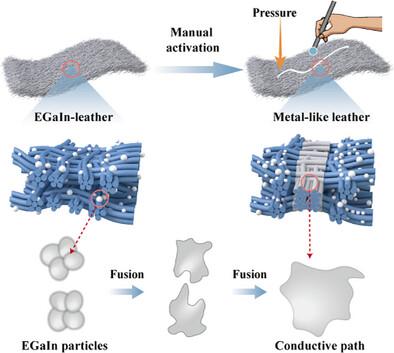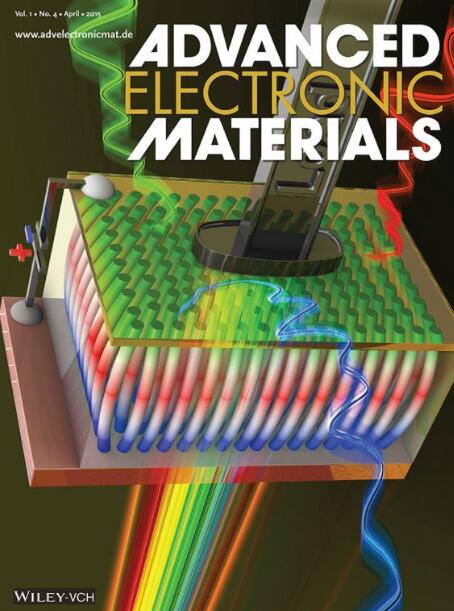手动激活皮革中的金属样图案以实现稳定的电信号传输
IF 5.3
2区 材料科学
Q2 MATERIALS SCIENCE, MULTIDISCIPLINARY
引用次数: 0
摘要
皮革由于其独特的透气性和坚固的结构稳定性,已成为柔性电子领域的普遍基材。然而,其复杂的层次结构在实现应变不敏感、低电阻电路模式方面存在障碍,从而阻碍了多功能和精确电信号传输的无缝集成。在这项研究中,共晶镓铟合金(EGaIn)纳米颗粒成功地与皮革复合,通过手动激活产生图案金属样皮革(MLL),从而消除了对面罩的需要。所得MLL的电导率为246 S m−1,导电线宽度为0.5至9 mm。值得注意的是,经过500次严格的150°折叠和10,000次抛光后,它保留了其卓越的电气性能。此外,MLL还具有良好的透气性和安全性。这些特性使其能够检测生理信号并保持稳定的电信号传输。MLL的发展也为多功能皮革电子产品的制造奠定了基础。本文章由计算机程序翻译,如有差异,请以英文原文为准。

Manual Activation of Metal-Like Patterns in Leather for Stable Electrical Signal Transmission
Leather has emerged as a prevalent substrate in the realm of flexible electronics, owing to its distinctive breathability and robust structural stability. However, its intricate hierarchical structure presents obstacles in achieving strain-insensitive, low-resistance circuit patterns, thereby impeding the seamless integration of multifunctionality and precise electric signal transmission. In this study, eutectic gallium indium alloy (EGaIn) nanoparticles are successfully compounded with leather to create patterned metal-like leather (MLL) through manual activation, eliminating the need for a mask. The resultant MLL has an electrical conductivity of 246 S m−1, with conductive line widths ranging from 0.5 to 9 mm. Notably, after enduring 500 cycles of rigorous 150° folding and 10 000 cycles of polishing, it retains its exceptional electrical property. Furthermore, the MLL exhibits excellent air permeability and safety. These attributes empower it to detect physiological signals and maintain stable electric signal transmission. The development of MLL also lays the groundwork for the fabrication of multifunctional leather electronics.
求助全文
通过发布文献求助,成功后即可免费获取论文全文。
去求助
来源期刊

Advanced Electronic Materials
NANOSCIENCE & NANOTECHNOLOGYMATERIALS SCIE-MATERIALS SCIENCE, MULTIDISCIPLINARY
CiteScore
11.00
自引率
3.20%
发文量
433
期刊介绍:
Advanced Electronic Materials is an interdisciplinary forum for peer-reviewed, high-quality, high-impact research in the fields of materials science, physics, and engineering of electronic and magnetic materials. It includes research on physics and physical properties of electronic and magnetic materials, spintronics, electronics, device physics and engineering, micro- and nano-electromechanical systems, and organic electronics, in addition to fundamental research.
 求助内容:
求助内容: 应助结果提醒方式:
应助结果提醒方式:


